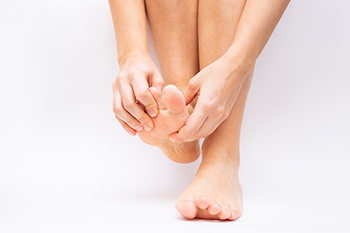Items filtered by date: July 2022
Compression Socks and a Cold Foot Soak

There are many people who have jobs that require standing and working on their feet. Foot pain is a common ailment among people who are in this category and it can be reduced or diminished when the proper footwear is worn. It is beneficial to wear a shoe with a small heel and weakness and soreness can be reduced when work shoes have proper arch support. It is important that shoes fit correctly as this may prevent poor circulation and blisters from developing. Some people choose to wear compression socks, which can be helpful in reducing blood flow to the feet, and redirecting it toward the heart. When the workday is finished, the feet will feel better when they are soaked in cold water followed by massaging them. This is beneficial in reducing inflammation and swelling that can happen during the work day. If you would like additional information about how your feet can feel better at the end of the day, please speak with a podiatrist who can offer you effective foot care tips.
While working on the feet, it is important to take the proper care of them. For more information about working on your feet, contact one of our podiatrists from Podiatry Associates of Victoria. Our doctors will treat your foot and ankle needs.
Working on Your Feet
Standing on your feet for long periods of time can cause stress and pain in your feet. Your whole body may experience change in terms of posture, back pain, bunions, callouses and or plantar warts. There are ways to avoid these conditions with proper foot care, smart choices and correct posture.
Positive Changes
Negative heeled shoe – Choosing this shoe type places the heel slightly lower than the ball of the foot. These are great for overall foot health. Find shoes that fit you correctly.
Go barefoot – Our feet were not designed to be enclosed for all hours of the day. Try to periodically expose your feet to air.
Eliminate Pain
Foot Exercises – Performing simple exercises, incorporating yoga and doing stretches are beneficial. This will allow increased blood flow to the area and muscles of the foot.
Achilles tendon – Stretching the foot out flat on the floor will relax the calf muscles and tendon. These exercises can be performed almost anywhere. Make sure you add these exercises to your daily regimen.
With a little bit of this information and knowing more about foot health, you will notice changes. Foot stretches and proper footwear will help with pain and prevent further issues.
If you have any questions please feel free to contact our office located in Victoria, TX . We offer the newest diagnostic and treatment technologies for all your foot and ankle needs.
Symptoms and Treatment for a Broken Ankle

A broken ankle is easy to notice. It produces severe pain and discomfort after a fall has taken place, and it is often impossible to walk on. Additional symptoms include a numbness in the ankle and surrounding area, swelling, and bruising. To determine if the ankle is fractured, an X-ray is generally taken, and this is helpful in determining the exact location of the break. If the break is severe, an MRI or CT scan may be ordered that can show if there is tissue damage or other injuries. A broken ankle is often treated by wearing a cast or a boot for several weeks. This is beneficial in keeping the ankle stable as the healing process occurs. Additionally, when the ankle is elevated above the heart, the swelling is often reduced, and it may provide relief. If additional symptoms occur, such as warm and tender legs, or if your toenails start to turn gray or blue, immediate attention from a podiatrist is strongly advised. Please consult with a podiatrist who can effectively treat broken ankles.
Broken ankles need immediate treatment. If you are seeking treatment, contact one of our podiatrists from Podiatry Associates of Victoria. Our doctors can provide the care you need to keep you pain-free and on your feet.
Broken Ankles
A broken ankle is experienced when a person fractures their tibia or fibula in the lower leg and ankle area. Both of these bones are attached at the bottom of the leg and combine to form what we know to be our ankle.
When a physician is referring to a break of the ankle, he or she is usually referring to a break in the area where the tibia and fibula are joined to create our ankle joint. Ankles are more prone to fractures because the ankle is an area that suffers a lot of pressure and stress. There are some obvious signs when a person experiences a fractured ankle, and the following symptoms may be present.
Symptoms of a Fractured Ankle
- Excessive pain when the area is touched or when any pressure is placed on the ankle
- Swelling around the area
- Bruising of the area
- Area appears to be deformed
If you suspect an ankle fracture, it is recommended to seek treatment as soon as possible. The sooner you have your podiatrist diagnose the fracture, the quicker you’ll be on the way towards recovery.
If you have any questions, please feel free to contact our office located in Victoria, TX . We offer the newest diagnostic and treatment technologies for all your foot care needs.
Plantar Warts Can Be Treated!
Mitigating the Effects of High Heels

Before leaving for a night out or preparing for a fancy event, many women will choose to complete their outfit by wearing a fashionable pair of high heels. Although such footwear is undoubtedly chic and visually striking, it can also cause serious and lasting damage to your feet. For example, when wearing a pair of high heels, one’s Achilles tendon tightens and shrinks, which can be painful and strain the lower leg muscles. In the long term, wearing these shoes for an extended period of time can even contribute to plantar fasciitis, a troublesome foot ailment. Although high heels can certainly pose a serious threat to the health of your feet, there are steps you can take to mitigate the detrimental effects of high heels. First, if you must wear high heels for an event, try to reduce the amount of time that you wear them. You might try waiting to put on your shoes until just before leaving and taking them off after approximately four hours at most. Second, if you must wear high heels, try to select a pair that offers a lower heel (i.e. an inch and a half). You might also try to find heels that are wider or chunkier, as these kinds of heels are more stable and won’t place too much pressure on your feet. Selecting the right kind of high heels and wearing them properly are a critical component of the health of your feet. For more information about high heels, contact a podiatrist.
High heels have a history of causing foot and ankle problems. If you have any concerns about your feet or ankles, contact one of our podiatrists from Podiatry Associates of Victoria. Our doctors can provide the care you need to keep you pain-free and on your feet.
Effects of High Heels on the Feet
High heels are popular shoes among women because of their many styles and societal appeal. Despite this, high heels can still cause many health problems if worn too frequently.
Which Parts of My Body Will Be Affected by High Heels?
- Ankle Joints
- Achilles Tendon – May shorten and stiffen with prolonged wear
- Balls of the Feet
- Knees – Heels cause the knees to bend constantly, creating stress on them
- Back – They decrease the spine’s ability to absorb shock, which may lead to back pain. The vertebrae of the lower back may compress.
What Kinds of Foot Problems Can Develop from Wearing High Heels?
- Corns
- Calluses
- Hammertoe
- Bunions
- Morton’s Neuroma
- Plantar Fasciitis
How Can I Still Wear High Heels and Maintain Foot Health?
If you want to wear high heeled shoes, make sure that you are not wearing them every day, as this will help prevent long term physical problems. Try wearing thicker heels as opposed to stilettos to distribute weight more evenly across the feet. Always make sure you are wearing the proper shoes for the right occasion, such as sneakers for exercising. If you walk to work, try carrying your heels with you and changing into them once you arrive at work. Adding inserts to your heels can help cushion your feet and absorb shock. Full foot inserts or metatarsal pads are available.
If you have any questions please feel free to contact our office located in Victoria, TX . We offer the newest diagnostic and treatment technologies for all your foot and ankle needs.
Facts About Capsulitis of the Second Toe

The foot has 30 ligaments, five of which connect the long bones of the midfoot (metatarsals) to the toes (phalanges). The ligaments form a capsule around the joint, helping it to work properly when you walk, run, or jump. When such a ligament becomes inflamed, it causes a pain called capsulitis. The most common form of this condition occurs in the second toe, often the result of a bunion, a longer second toe, flat feet, or low arches. It is sometimes mistaken for Morton’s neuroma, but that is a separate condition that affects the nerves. Capsulitis of the second toe is progressive and worsens over time, usually because of genetics or overuse. Long-term wearing of high heels may also have contributed to this. A podiatrist can examine your foot to detect the source of the pain using an X-ray and manipulation of the affected area. Conservative treatments, such as ice, rest, medication, and orthotics may be recommended. Changing footwear, taping, and splinting can also help. If these methods are not effective, or if your condition is particularly advanced, surgery may be another option.
Toe pain can disrupt your daily activities. If you have any concerns, contact one of our podiatrists of Podiatry Associates of Victoria. Our doctors can provide the care you need to keep you pain-free and on your feet.
What Causes Toe Pain?
Most severe toe pain is caused due to a sports injury, trauma from dropping something heavy on the toe, or bumping into something rigid. Other problems can develop over time for various reasons.
Toe pain can be caused by one or more ailments. The most common include:
- Trauma
- Sports injury
- Wearing shoes that are too tight
- Arthritis
- Gout
- Corns and calluses
- Hammertoe
- Bunions
- Blisters
- Ingrown toenails
- Sprains
- Fractures (broken bones)
- Dislocations
When to See a Podiatrist
- Severe pain
- Persistent pain that lasts more than a week
- Signs of infection
- Continued swelling
- Pain that prevents walking
Diagnosis
In many cases the cause of toe pain is obvious, but in others, a podiatrist may want to use more advanced methods to determine the problem. These can range from simple visual inspections and sensation tests to X-rays and MRI scans. Prior medical history, family medical history, and any recent physical traumatic events will all be taken into consideration for a proper diagnosis.
Treatment
Treatments for toe pain and injuries vary and may include shoe inserts, padding, taping, medicines, injections, and in some cases, surgery. If you believe that you have broken a toe, please see a podiatrist as soon as possible.
If you have any questions please feel free to contact our office located in Victoria, TX . We offer the newest diagnostic tools and technology to treat your foot and ankle needs.

